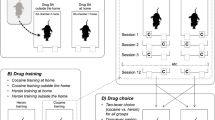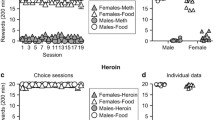Abstract
Rationale
Previous studies have shown that the effect of setting on drug-taking is substance specific in both humans and rats. In particular, we have shown that when the setting of drug self-administration (SA) coincides with the home environment of the rats (resident rats), the rats tend to prefer heroin to cocaine. The opposite was found in nonresident rats, for which the SA chambers represented a distinct environment.
Objectives
The aim of the present study was to investigate the influence of setting on the ability of different doses of cocaine and heroin to prime cocaine- versus heroin-seeking in rats that had been trained to self-administer both drugs and had then undergone an extinction procedure.
Methods
Resident (N = 62) and nonresident (N = 63) rats with double-lumen intra-jugular catheters were trained to self-administer cocaine (400 μg/kg/infusion) and heroin (25 μg/kg/infusion) on alternate days for 10 consecutive daily sessions (3 h each). After the extinction phase, independent groups of rats were given a noncontingent intravenous infusion of heroin (25, 50, or 100 μg/kg) or cocaine (400, 800, or 1600 μg/kg), and drug-seeking was quantified by counting nonreinforced lever presses.
Results
All resident and nonresident rats acquired heroin and cocaine SA. However, cocaine primings reinstated cocaine-seeking only in nonresident rats, whereas heroin primings reinstated heroin-seeking only in resident rats.
Conclusions
We report here that the susceptibility to relapse into drug-seeking behavior is drug-specific and setting-specific, confirming the crucial role played by drug, set, and setting interactions in drug addiction.




Similar content being viewed by others
References
American Psychiatric Association (2013) Diagnostic and statistical manual of mental disorders, 5th edn. American Psychiatric Press, Washington, DC
Badiani A (2013) Substance-specific environmental influences on drug use and drug preference in animals and humans. Curr Opin Neurobiol 23:588–596
Badiani A (2014) Is a “general” theory of addiction possible? A commentary on: a multistep general theory of transition to addiction. Psychopharmacology (Berl) 231:3923–3927
Badiani A, Spagnolo PA (2013) Role of environmental factors in cocaine addiction. Curr Pharm Des 19:6996–7008
Badiani A, Belin D, Epstein D, Calu D, Shaham Y (2011) Opiate versus psychostimulant addiction: the differences do matter. Nat Rev Neurosci 12:685–700
Bradley BP, Phillips G, Green L, Gossop M (1989) Circumstances surrounding the initial lapse to opiate use following detoxification. Br J Psychiatry 154:354–359
Brown SA, Vik PW, Patterson TL, Grant I, Schuckit MA (1995) Stress, vulnerability and adult alcohol relapse. J Stud Alcohol 56:538–545
Caprioli D, Celentano M, Paolone G, Badiani A (2007a) Environmental modulation of cocaine self-administration in the rat. Psychopharmacology (Berl) 192:397–406
Caprioli D, Celentano M, Paolone G, Badiani A (2007b) Modeling the role of environment in addiction. Prog Neuropsychopharmacol Biol Psychiatry 31:1639–1653
Caprioli D, Celentano M, Paolone G, Lucantonio F, Bari A, Nencini P, Badiani A (2008) Opposite environmental regulation of heroin and amphetamine self-administration in the rat. Psychopharmacology (Berl) 198:395–404
Caprioli D, Celentano M, Dubla A, Lucantonio F, Nencini P, Badiani A (2009) Ambience and drug choice: cocaine- and heroin-taking as a function of environmental context in humans and rats. Biol Psychiatry 65:893–899
Carelli RM, Ijames SG (2000) Nucleus accumbens cell firing during maintenance, extinction, and reinstatement of cocaine self-administration behavior in rats. Brain Res 866:44–54
Carrera MR, Ashley JA, Zhou B, Wirsching P, Koob GF, Janda KD (2000) Cocaine vaccines: antibody protection against relapse in a rat model. Proc Natl Acad Sci U S A 97:6202–6206
Celentano M, Caprioli D, Di Pasquale P, Cardillo V, Nencini P, Gaetani S, Badiani A (2009) Drug context differently regulates cocaine versus heroin self-administration and cocaine- versus heroin-induced Fos mRNA expression in the rat. Psychopharmacology (Berl) 204:349–360
Crombag HS, Bossert JM, Koya E, Shaham Y (2008) Review. Context-induced relapse into drug seeking: a review. Philos Trans R Soc Lond B Biol Sci 363:3233–3243
Daglish MR, Williams TM, Wilson SJ, Taylor LG, Eap CB, Augsburger M et al (2008) Brain dopamine response in human opioid addiction. Br J Psychiatry 193:65–72
De Luca MT, Badiani A (2011) Ketamine self administration in the rat: evidence for a critical role of setting. Psychopharmacology (Berl) 214:549–556
De Luca MT, Meringolo M, Spagnolo PA, Badiani A (2012) The role of setting for ketamine abuse: clinical and preclinical evidence. Rev Neurosci 23:769–780
de Wit H, Stewart J (1981) Reinstatement of cocaine-reinforced responding in the rat. Psychopharmacology (Berl) 75:134–143
Dillon P, Copeland J, Jansen K (2003) Patterns of use and harms associated with non-medical ketamine use. Drug Alcohol Depend 69:23–28
Ettenberg A, Pettit HO, Bloom FE, Koob GF (1982) Heroin and cocaine intravenous self-administration in rats: mediation by separate neural systems. Psychopharmacology (Berl) 78:204–209
Fattore L, Spano MS, Cossu G, Deiana S, Fratta W (2003) Cannabinoid mechanism in reinstatement of heroin-seeking after a long period of abstinence in rats. Eur J Neurosci 17:1723–1726
Fattore L, Spano S, Cossu G, Deiana S, Fadda P, Fratta W (2005) Cannabinoid CB(1) antagonist SR 141716A attenuates reinstatement of heroin self-administration in heroin-abstinent rats. Neuropharmacology 48:1097–1104
Gerrits MA, Van Ree JM (1996) Effect of nucleus accumbens dopamine depletion on motivational aspects involved in initiation of cocaine and heroin self-administration in rats. Brain Res 713:114–124
Hancock PJ, Stamford JA (1999) Stereospecific effects of ketamine on dopamine efflux and uptake in the rat nucleus accumbens. Br J Anaesth 82:603–608
Jaffe JH, Cascella NG, Kumor KM, Sherer MA (1989) Cocaine-induced cocaine craving. Psychopharmacology 97:59–64
Johnson BA, Ait-Daoud N (2005) Alcohol: clinical aspects. In: Lowinson JH, Ruiz P, Millman RB, Langrod JG (eds) Substance abuse: a comprehensive textbook, 4th edn. Lippincott Williams & Wilkins, Philadelphia, pp 151–163
Kelleher RT, Morse WH (1968) Determinants of the specificity of behavioral effects of drugs. Ergeb Physiol 60:1–56
Lenoir M, Ahmed SH (2007) Heroin-induced reinstatement is specific to compulsive heroin use and dissociable from heroin reward and sensitization. Neuropsychopharmacology 32:616–624
Leri F, Stewart J (2001) Drug-induced reinstatement to heroin and cocaine seeking: a rodent model of relapse in polydrug use. Exp Clin Psychopharmacol 9:297–306
Leri F, Tremblay A, Sorge RE, Stewart J (2004) Methadone maintenance reduces heroin- and cocaine-induced relapse without affecting stress-induced relapse in a rodent model of poly-drug use. Neuropsychopharmacology 29:1312–1320
Ludwig AM, Wikler A, Stark LH (1974) The first drink: psychobiological aspects of craving. Arch Gen Psychiatry 30:539–547
Luo F, Xi ZX, Wu G, Liu C, Gardner EL, Li SJ (2004) Attenuation of brain response to heroin correlates with the reinstatement of heroin-seeking in rats by fMRI. Neuroimage 22:1328–1335
Marchant NJ, Rabei R, Kaganovsky K, Caprioli D, Bossert JM, Bonci A, Shaham Y (2014) A critical role of lateral hypothalamus in context-induced relapse into alcohol seeking after punishment-imposed abstinence. J Neurosci 34:7447–7457
Morean ME, Corbin WR (2010) Subjective response to alcohol: a critical review of the literature. Alcohol Clin Exp Res 34:385–395
Nestler EJ (2004) Historical review: molecular and cellular mechanisms of opiate and cocaine addiction. Trends Pharmacol Sci 25:210–218
Nyaronga D, Greenfield TK, McDaniel PA (2009) Drinking context and drinking problems among black, white, and Hispanic men and women in the 1984, 1995, and 2005 U.S. National Alcohol Surveys. J Stud Alcohol Drugs 70:16–26
O’Brien CP, Childress AR, McLellan AT, Ehrman R (1992) Classical conditioning in drug-dependent humans. Ann NY Acad Sci 654:400–415
Peters J, Pattij T, De Vries TJ (2013) Targeting cocaine versus heroin memories: divergent roles within ventromedial prefrontal cortex. Trends Pharmacol Sci 34:689–695
Pettit HO, Ettenberg A, Bloom FE, Koob GF (1984) Destruction of dopamine in the nucleus accumbens selectively attenuates cocaine but not heroin selfadministration in rats. Psychopharmacology (Berl) 84:167–173
Shaham Y, Shalev U, Lu L, De Wit H, Stewart J (2003) The reinstatement model of drug relapse: history, methodology and major findings. Psychopharmacology (Berl) 168:3–20
Sinha R (2001) How does stress increase risk of drug abuse and relapse? Psychopharmacology (Berl) 15:343–359
Sorge RE, Rajab H, Stewart J (2005) Rats maintained chronically on buprenorphine show reduced heroin and cocaine seeking in tests of extinction and drug-induced reinstatement. Neuropsychopharmacology 30:1681–1692
Testa A, Nencini P, Badiani A (2011) The role of setting in the oral self administration of alcohol in the rat. Psychopharmacology (Berl) 215:749–760
Tran-Nguyen LT, Bellew JG, Grote KA, Neisewander JL (2001) Serotonin depletion attenuates cocaine seeking but enhances sucrose seeking and the effects of cocaine priming on reinstatement of cocaine seeking in rats. Psychopharmacology 157:340–348
Watson BJ, Taylor LG, Reid AG, Wilson SJ, Stokes PR, Brooks DJ et al (2014) Investigating expectation and reward in human opioid addiction with [11C]raclopride PET. Addict Biol 19:1032–1040
Zinberg NE (1984) Drug, set, and setting: the basis for controlled intoxicant use. Yale University Press, New Haven
Acknowledgments
This work was supported by grants from Sapienza University of Rome. Husbandry and procedures were in accordance with the Italian Law on Animal Research (DLGS 116/92) and with the guidelines for the care and use of laboratory animals issued by Italian Ministry of Health, the country in which the experiments were performed.
Conflict of interest
The authors report no biomedical financial interests or potential conflicts of interest.
Author information
Authors and Affiliations
Corresponding author
Rights and permissions
About this article
Cite this article
Montanari, C., Stendardo, E., De Luca, M.T. et al. Differential vulnerability to relapse into heroin versus cocaine-seeking as a function of setting. Psychopharmacology 232, 2415–2424 (2015). https://doi.org/10.1007/s00213-015-3877-2
Received:
Accepted:
Published:
Issue Date:
DOI: https://doi.org/10.1007/s00213-015-3877-2




